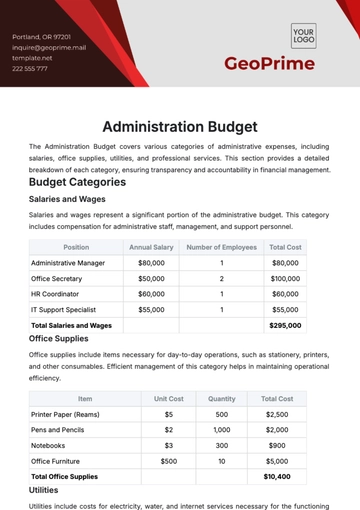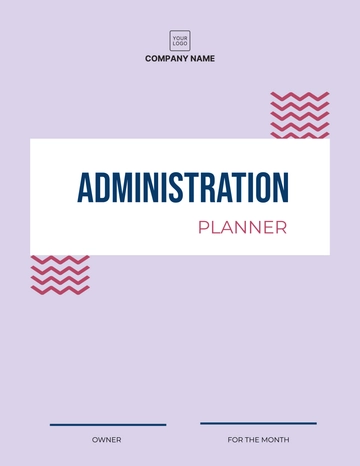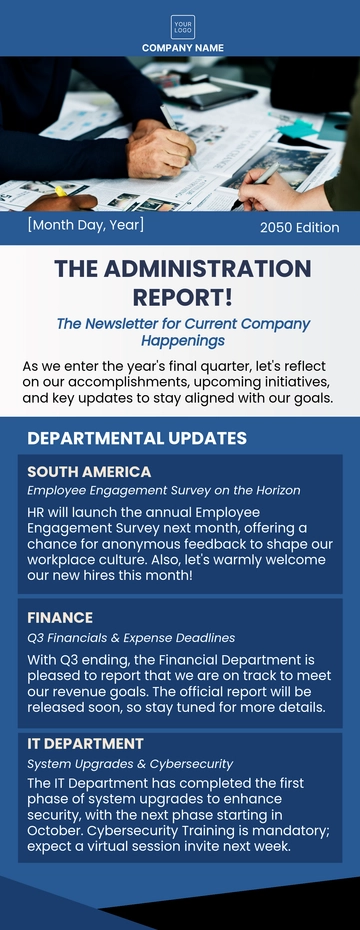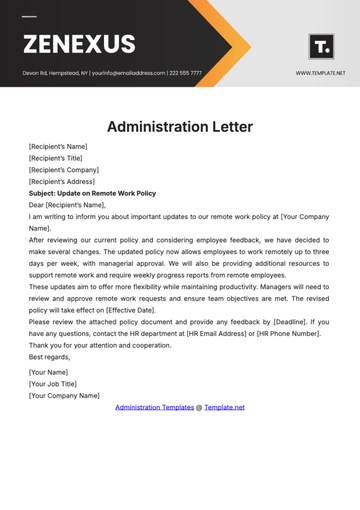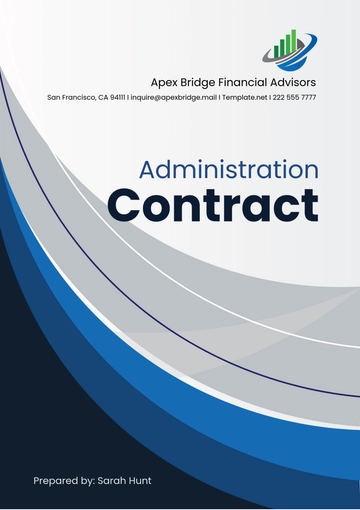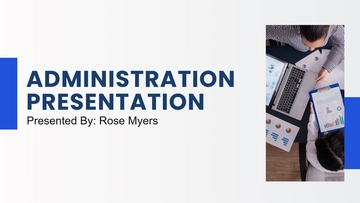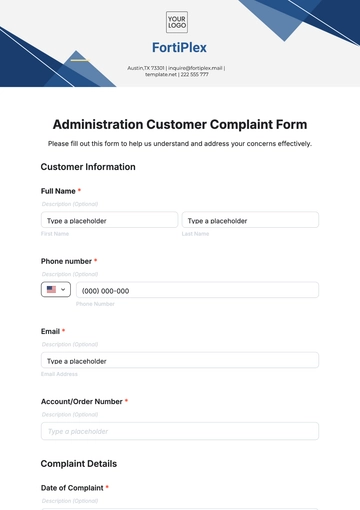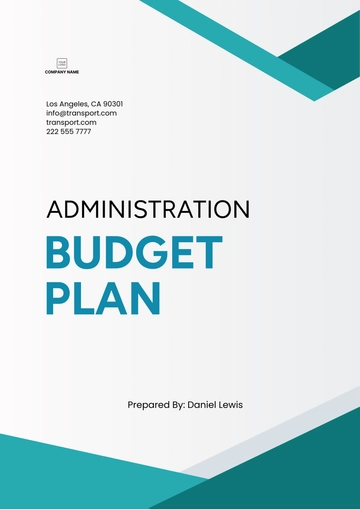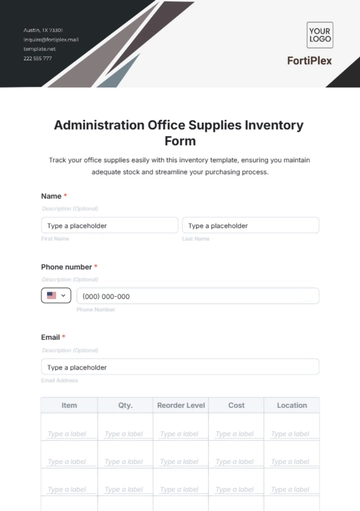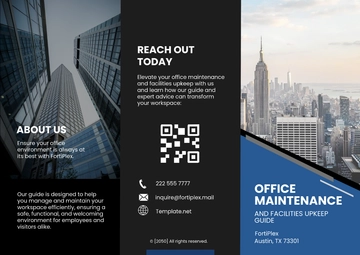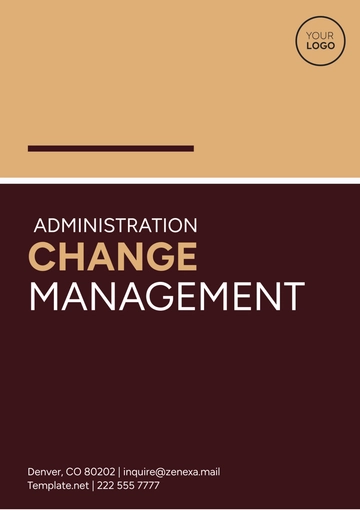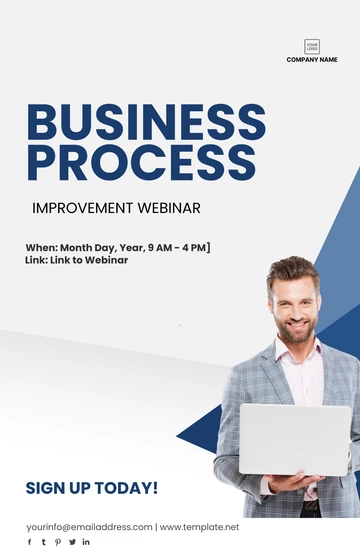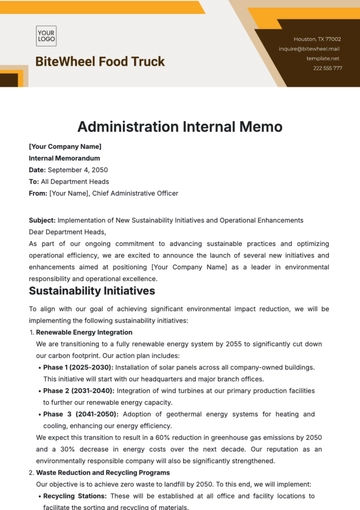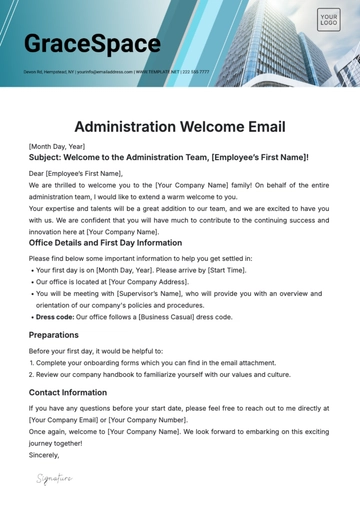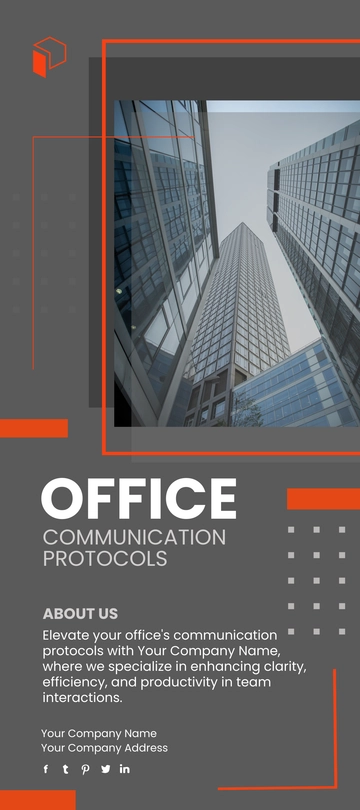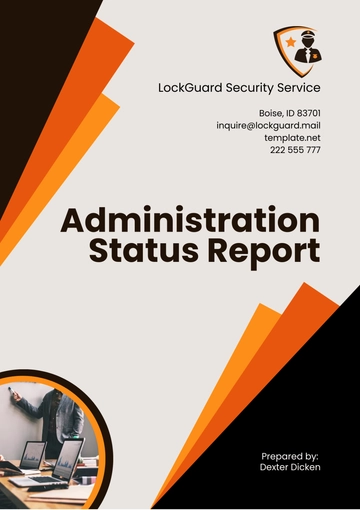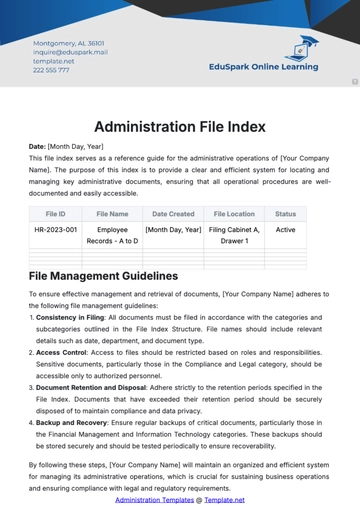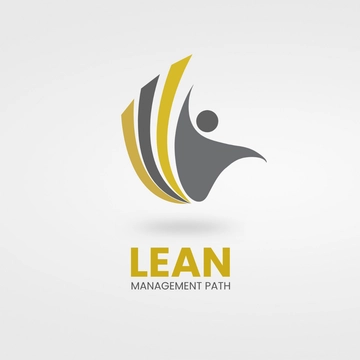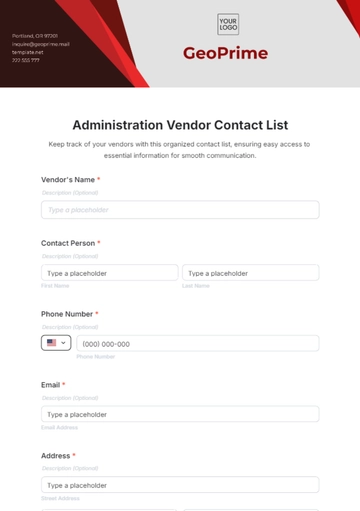Free Administration Document Workflow Optimization Guide
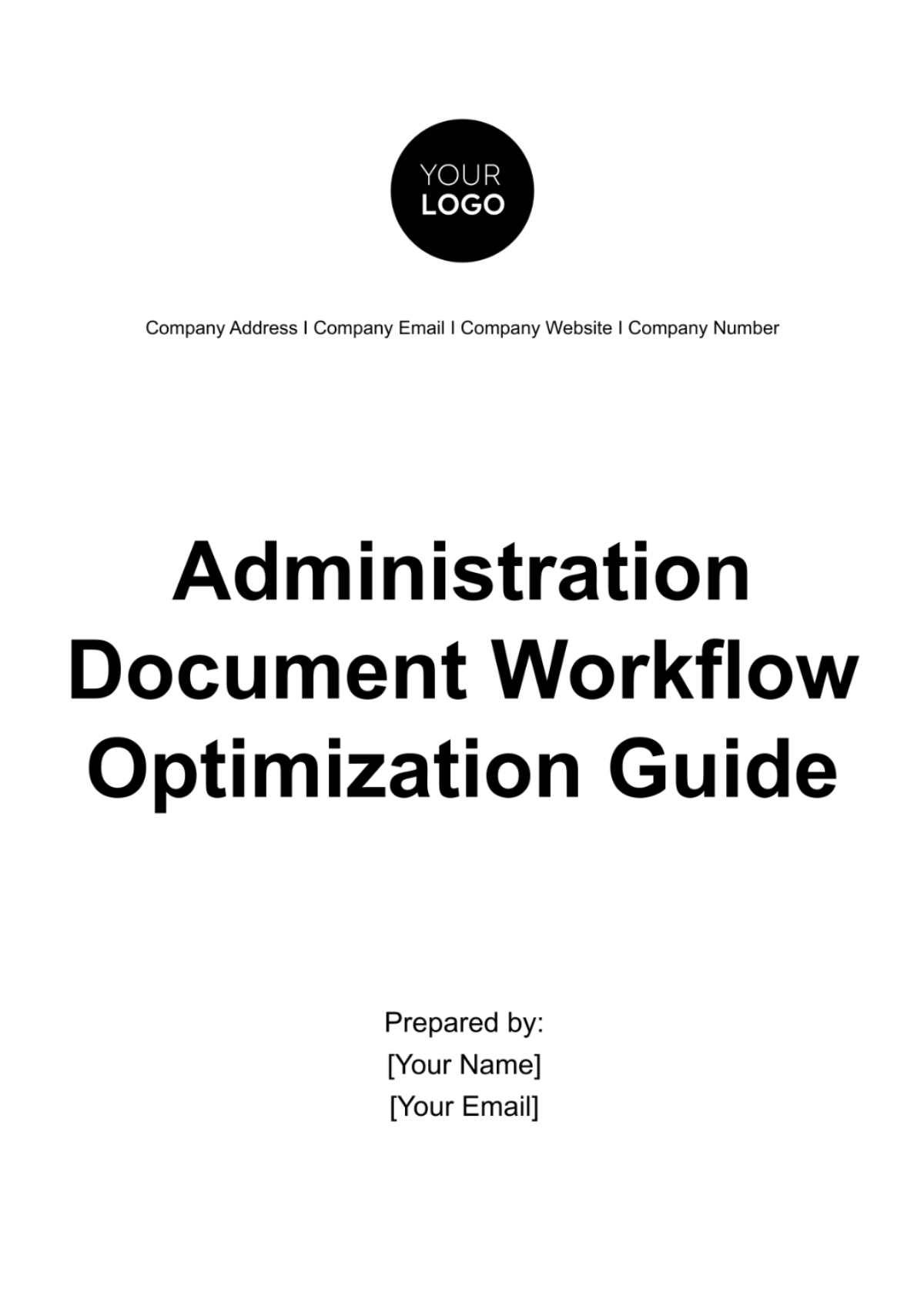
I. Introduction to Document Workflow Optimization
In today's fast-paced business environment, efficient document management is crucial for the success of any organization. [Your Company Name] recognizes the significance of streamlining document workflows to enhance productivity, reduce errors, and ensure compliance with regulations. This guide aims to provide a comprehensive overview of optimizing document workflows within our administrative processes.
II. Importance of Efficient Document Workflows
Efficient document workflows are the backbone of organizational operations. They facilitate seamless communication, collaboration, and decision-making across departments. By optimizing document workflows, [Your Company Name] can minimize delays, improve accuracy, and enhance customer satisfaction. Moreover, streamlined workflows enable better resource allocation, leading to cost savings and improved competitiveness in the market.
III. Current Document Workflow Analysis
A comprehensive analysis of our current document workflows is essential for identifying inefficiencies, bottlenecks, and areas for improvement. Here's an overview of our current document workflow analysis:
A. Document Mapping:
Identification of Document Types: We have identified various types of documents circulating within [Your Company Name], including invoices, contracts, reports, and correspondence. Each document type has its unique characteristics and requirements.
Document Sources and Destinations: We have mapped out the origin and destination of each document, identifying key stakeholders involved in the workflow. This includes internal departments, external partners, and regulatory bodies.
Document Lifecycle: We have traced the lifecycle of documents from creation to storage or disposal, documenting each stage and any associated processes. This includes document creation, review, approval, distribution, and archiving.
B. Workflow Mapping:
Process Mapping: We have visualized the current workflow for each document type, outlining the sequence of steps involved in its processing. This includes the roles and responsibilities of each stakeholder, decision points, and handoff points between departments.
Workflow Variations: We have identified any deviations or alternate pathways within the workflows, such as expedited approvals or exception-handling processes. Understanding these variations helps us streamline processes and ensure consistency.
Integration Points: We have highlighted integration points with other systems or departments, such as data entry into accounting software or document sharing with external partners. This ensures seamless information flow and avoids duplication of efforts.
C. Pain Points and Bottlenecks:
Identification of Pain Points: Through stakeholder feedback and process observations, we have identified pain points and inefficiencies in the current document workflows. These may include manual data entry, redundant approval processes, and delays in document routing.
Bottleneck Analysis: We have identified bottlenecks where document processing slows down or stalls, causing delays and impacting productivity. Common bottlenecks include overloaded approval queues, manual handoffs, and lack of visibility into workflow status.
Root Cause Analysis: We have conducted root cause analysis to determine the underlying reasons for bottlenecks and inefficiencies. This includes factors such as outdated technology, unclear approval hierarchies, and lack of standardized procedures.
D. Compliance and Risk Assessment:
Regulatory Compliance: We have assessed the current document workflows for compliance with industry regulations, legal requirements, and internal policies. This ensures that our processes adhere to relevant standards and mitigate compliance risks.
Data Security and Privacy: We have evaluated the security measures in place to protect sensitive information throughout the document lifecycle. This includes access controls, encryption, and audit trails to safeguard against data breaches and unauthorized access.
Risk Identification: We have identified potential risks associated with document workflows, such as data breaches, compliance violations, or loss of critical information. By understanding these risks, we can implement appropriate controls and mitigation strategies.
E. Technology Assessment:
Current Technology Stack: We have reviewed the existing technology solutions used for document management, including document management systems, collaboration tools, and workflow automation software. This includes assessing their functionality, usability, and integration capabilities.
Technology Gaps: We have identified any gaps or limitations in the current technology stack that hinder efficient document workflows. This may include outdated systems, lack of integration between tools, or scalability issues.
Opportunities for Improvement: We have explored opportunities to leverage emerging technologies such as artificial intelligence, machine learning, and robotic process automation to optimize document workflows. This includes assessing the feasibility and potential benefits of implementing new technologies.
The table below summarizes the steps involved in conducting Current Document Workflow Analysis within [Your Company Name]:
Step | Description |
|---|---|
Document Mapping | Identify various types of documents circulating within the organization, including their sources and destinations. |
Workflow Mapping | Visualize the current workflow for each document type, outlining the sequence of steps involved in its processing. |
Pain Points Identification | Identify pain points and inefficiencies in the current document workflows through stakeholder feedback and observation. |
Bottleneck Analysis | Analyze the workflow to identify bottlenecks where document processing slows down or stalls, causing delays. |
Root Cause Analysis | Conduct root cause analysis to determine the underlying reasons for bottlenecks and inefficiencies. |
Compliance and Risk Assessment | Assess the current document workflows for compliance with industry regulations, legal requirements, and internal policies. |
Technology Assessment | Review the existing technology solutions used for document management and assess their functionality and integration capabilities. |
IV. Identification of Bottlenecks and Inefficiencies
Identifying bottlenecks and inefficiencies within our document workflows is crucial for improving operational efficiency and productivity. Through a comprehensive analysis, we have pinpointed several areas where our current processes may be hindering workflow effectiveness:
A. Manual Processes:
Data Entry: Manual data entry processes are prone to errors and can significantly slow down document processing times. The reliance on manual input increases the risk of data inaccuracies and delays in document processing.
Document Handling: Manual handling of documents, such as physical routing or manual filing, introduces unnecessary delays and increases the likelihood of misplaced or lost documents. This manual intervention adds time to the document lifecycle and can lead to inefficiencies.
Approval Processes: Manual approval processes often involve multiple stakeholders and require coordination across departments. Delays in obtaining approvals, due to factors such as conflicting schedules or unclear approval hierarchies, can lead to bottlenecks and hinder workflow progress.
B. Redundant or Unnecessary Steps:
Approval Chains: Complex approval chains with multiple levels of review may result in redundant approval steps, leading to delays in document processing. Reviewing and streamlining approval workflows can help eliminate unnecessary steps and expedite the approval process.
Document Review: Excessive document reviews or multiple rounds of revisions can prolong document processing times and introduce unnecessary delays. Assessing the frequency and necessity of document reviews can help streamline workflows and improve efficiency.
Document Routing: Inefficient document routing paths, including unnecessary detours or loops, can prolong the document lifecycle and delay critical tasks. Simplifying and optimizing document routing paths can help minimize delays and improve workflow efficiency.
C. Lack of Standardization:
Document Formats: Inconsistent document formats and templates across departments or processes can lead to confusion and inefficiencies. Standardizing document templates and formats ensures consistency and facilitates document processing.
Naming Conventions: Unclear or inconsistent naming conventions for documents, folders, and files can make it difficult to locate and retrieve documents efficiently. Establishing clear naming conventions improves document organization and accessibility.
Process Variations: Deviations from standardized procedures or inconsistent application of workflows can lead to inefficiencies and errors. Standardizing processes and ensuring adherence to established workflows helps maintain consistency and efficiency.
D. Communication and Collaboration:
Interdepartmental Communication: Inadequate communication channels between departments involved in document workflows can lead to delays and miscommunication. Improving communication channels and collaboration tools can facilitate smoother information exchange and workflow coordination.
Feedback Loops: Lack of effective feedback mechanisms for document revisions or updates can hinder collaboration and lead to misunderstandings. Implementing clear feedback loops ensures timely and constructive feedback, improving document quality and efficiency.
Collaboration Tools: Inefficient utilization of collaboration tools for document sharing and co-authoring can hinder collaboration and workflow efficiency. Promoting the use of collaboration platforms and providing training on their effective use enhances teamwork and productivity.
V. Streamlining Document Processes
Streamlining document processes is essential for optimizing efficiency and productivity within [Your Company Name]. By implementing the following strategies, we can simplify workflows, minimize errors, and enhance collaboration across departments:
A. Standardization of Document Templates:
To ensure consistency and clarity in our documents, we will develop standardized templates for common document types such as reports, invoices, contracts, and forms. These templates will feature uniform formatting, layout, and branding elements, streamlining the creation process and enhancing professionalism.
B. Implementation of Electronic Signatures:
We will adopt electronic signature tools to expedite document approvals and reduce reliance on manual processes. Electronic signatures provide a secure and legally binding way to sign documents, allowing for faster turnaround times and improved compliance with regulatory requirements.
C. Centralization of Document Repositories:
By implementing a robust Document Management System (DMS), we will centralize document storage, organization, and retrieval. This centralized approach will simplify access to documents, enhance version control, and improve collaboration among team members.
D. Automation of Routine Tasks:
Identifying repetitive tasks within document workflows, we will leverage workflow automation tools to automate them. This includes automating data entry processes, notifications for pending tasks, and reminders for deadlines, reducing manual effort and minimizing errors.
E. Integration with Collaboration Platforms:
Integrating document workflows with collaboration platforms such as Microsoft Teams or Slack will facilitate seamless communication and collaboration among team members. Real-time co-authoring and version history tracking features will enhance teamwork and ensure document integrity.
F. Implementation of Document Workflow Guidelines:
Developing clear Standard Operating Procedures (SOPs) for document workflows will provide employees with step-by-step guidance on document handling processes. Comprehensive training and regular updates to these guidelines will ensure adherence to best practices and continuous improvement.
G. Adoption of Mobile Document Management:
Enabling mobile access to document management systems and implementing offline sync capabilities will empower employees to access, review, and approve documents from anywhere, at any time. This flexibility enhances productivity and ensures business continuity, even in remote or offline environments.
H. Continuous Process Improvement:
Establishing key performance indicators (KPIs) and soliciting feedback from stakeholders will enable us to track the effectiveness of our streamlining efforts. Through iterative optimization, we will continuously identify opportunities for improvement and refine our workflows to achieve optimal efficiency.
VI. Automation Opportunities
Automation presents significant opportunities for [Your Company Name] to streamline document workflows, reduce manual effort, and improve overall efficiency. By identifying and leveraging automation tools, we can enhance productivity, minimize errors, and free up valuable time for employees to focus on more strategic tasks. Here are some key automation opportunities we can explore:
A. Data Entry Automation:
Manual data entry processes are time-consuming and prone to errors. By implementing data entry automation tools, we can extract data from documents automatically and populate relevant fields in our systems. This not only accelerates the processing of documents but also improves accuracy by reducing human error.
B. Document Routing Automation:
Routing documents through approval workflows often involves manual interventions and delays. With document routing automation, we can establish predefined approval paths based on document types, roles, and permissions. Automated notifications and escalations can also be configured to ensure timely approvals and minimize bottlenecks.
C. Document Classification and Sorting:
Manually categorizing and sorting documents can be a tedious and error-prone task. Machine learning algorithms can be leveraged to automatically classify documents based on content, keywords, or metadata. This automation streamlines document organization, facilitates quick retrieval, and enhances overall efficiency.
D. Notification and Reminder Automation:
Keeping track of pending tasks and deadlines can be challenging in a fast-paced environment. Automation tools can send automated notifications and reminders to relevant stakeholders for upcoming tasks, deadlines, or document reviews. This proactive approach ensures that critical tasks are not overlooked and helps in maintaining workflow efficiency.
E. Electronic Signature Integration:
Traditional paper-based signature processes are not only time-consuming but also prone to delays, especially in remote or distributed teams. Integrating electronic signature solutions allows for the quick and secure signing of documents from anywhere, eliminating the need for physical presence and expediting approval processes.
F. Document Version Control:
Maintaining version control manually can lead to confusion and errors, particularly in collaborative environments. Automation tools can track document versions automatically, recording changes, revisions, and comments. This ensures that stakeholders always have access to the latest version of a document, promoting collaboration and reducing rework.
G. Data Validation and Error Checking:
Manually validating data and checking for errors can be resource-intensive and prone to oversight. Automation tools can perform data validation and error checking tasks automatically, flagging inconsistencies, duplicates, or missing information. This proactive approach improves data accuracy and ensures compliance with quality standards.
H. Report Generation and Distribution:
Generating reports manually can be time-consuming, especially for recurring or standardized reports. Automation tools can generate reports based on predefined templates and parameters, schedule report generation tasks, and distribute reports to relevant stakeholders automatically. This streamlines the reporting process and ensures timely access to critical information.
VII. Monitoring and Evaluation of Workflow Improvements
Monitoring and evaluating workflow improvements are essential to ensure that the implemented changes are effective in achieving the desired outcomes. Here are the key steps for monitoring and evaluating workflow improvements:
Establish Key Performance Indicators (KPIs):
Define specific KPIs that align with the objectives of the workflow improvements. These may include metrics such as processing times, error rates, throughput, customer satisfaction scores, and cost savings.
Set Baseline Measurements:
Measure the current performance of the workflow before implementing any changes to establish baseline measurements. This provides a benchmark against which the effectiveness of the improvements can be evaluated.
Implement Workflow Changes:
Implement the proposed workflow improvements based on the analysis and optimization strategies identified earlier in the process.
Continuous Monitoring:
Continuously monitor the performance of the workflow after implementing the changes. Use tracking tools, dashboards, or automated alerts to monitor KPIs in real-time or at regular intervals.
Collect Feedback:
Gather feedback from stakeholders, including employees, managers, and customers, regarding their experience with the new workflow. This feedback can provide valuable insights into the effectiveness of the changes and identify areas for further improvement.
Data Analysis:
Analyze the data collected from monitoring activities to assess the impact of the workflow improvements on key performance metrics. Compare the post-implementation data with baseline measurements to determine the extent of improvement.
Identify Successes and Challenges:
Identify successes where the workflow improvements have led to positive outcomes, such as reduced processing times or improved accuracy. Also, identify any challenges or unexpected issues that may have arisen during the implementation process.
Adjustments and Iterations:
Based on the evaluation findings, make adjustments to the workflow as needed to address any challenges or areas for improvement. Iteratively refine the workflow to optimize performance continually.
Document Results:
Document the results of the monitoring and evaluation process, including key findings, successes, challenges, and any adjustments made to the workflow. This documentation provides valuable insights for future workflow optimization efforts.
Communicate Results:
Communicate the results of the monitoring and evaluation process to relevant stakeholders, including management, employees, and other departments involved in the workflow. Share successes, lessons learned, and plans for ongoing optimization efforts.
Continuous Improvement:
Use the insights gained from the monitoring and evaluation process to inform future workflow improvement initiatives. Continuously strive for improvement by iterating on the workflow based on feedback, data analysis, and changing business needs.
VIII. Continuous Improvement Strategies
Optimizing document workflows is an ongoing process that requires continuous improvement efforts. [Your Company Name] fosters a culture of innovation and continuous learning within the organization, encouraging employees to identify opportunities for further optimization and efficiency gains. By embracing a mindset of continuous improvement, we can stay ahead of evolving business needs and maintain a competitive edge in the market.
Regular Performance Reviews:
Conduct regular reviews of workflow performance, analyzing key metrics and identifying areas for improvement. Set aside dedicated time to review workflow processes, solicit feedback from stakeholders, and assess the effectiveness of implemented changes.
Employee Training and Development:
Invest in ongoing training and development programs to ensure that employees are equipped with the skills and knowledge necessary to perform their roles effectively within the workflow. Provide training on new technologies, best practices, and process improvements to empower employees to contribute to continuous improvement efforts.
Kaizen Events:
Organize Kaizen events or improvement workshops focused on specific areas of the workflow. Bring together cross-functional teams to brainstorm ideas, identify inefficiencies, and implement rapid improvements. Kaizen events foster collaboration, creativity, and a culture of continuous improvement.
Lean Methodologies:
Apply lean principles and methodologies such as value stream mapping, 5S, and visual management to identify waste, streamline processes, and improve workflow efficiency. Continuously seek ways to eliminate non-value-added activities and optimize resource utilization.
Feedback Mechanisms:
Establish formal feedback mechanisms to gather input from employees, customers, and other stakeholders regarding their experiences with the workflow. Encourage open communication and actively solicit suggestions for improvement. Analyze feedback to identify trends and prioritize improvement initiatives.
Cross-Functional Collaboration:
Foster collaboration and knowledge sharing across departments and teams involved in the workflow. Encourage cross-functional teams to work together to identify improvement opportunities, share best practices, and implement solutions that span organizational boundaries.
Technology Adoption:
Stay abreast of technological advancements and explore opportunities to leverage new technologies to enhance workflow efficiency. Continuously evaluate and invest in innovative tools and solutions that automate tasks, streamline processes, and improve collaboration.
Benchmarking:
Benchmark workflow performance against industry standards and best practices to identify areas of strength and opportunities for improvement. Compare key metrics such as cycle times, error rates, and productivity levels with industry peers to gauge performance and prioritize improvement efforts.
Leadership Support and Engagement:
Secure leadership support and engagement for continuous improvement initiatives. Leadership buy-in is essential for allocating resources, setting priorities, and driving organizational change. Foster a culture where leaders actively champion and participate in improvement efforts.
Celebrate Successes and Learn from Failures:
Celebrate successes and recognize achievements resulting from continuous improvement efforts. Highlight successful initiatives, share lessons learned, and acknowledge the contributions of employees. Equally important, embrace failures as learning opportunities and use them to inform future improvement efforts.
Regular Review of Industry Trends:
Stay informed about industry trends, emerging technologies, and evolving customer expectations. Regularly assess how external factors may impact workflow processes and identify opportunities to adapt and innovate accordingly.
IX. Conclusion
In conclusion, optimizing document workflows is essential for enhancing productivity, reducing errors, and ensuring compliance within [Your Company Name]. By following the guidelines outlined in this document, we can streamline processes, leverage technology solutions, and empower employees to work more efficiently. By continuously monitoring, evaluating, and improving our document workflows, we can achieve operational excellence and drive sustainable growth in the digital age.
- 100% Customizable, free editor
- Access 1 Million+ Templates, photo’s & graphics
- Download or share as a template
- Click and replace photos, graphics, text, backgrounds
- Resize, crop, AI write & more
- Access advanced editor
Optimize document management with Template.net's Administration Document Workflow Optimization Guide Template. This editable template, accessible through our AI Editor Tool, streamlines workflow improvement efforts. With customizable fields and structured formats, it empowers you to develop a tailored guide for optimizing document workflows, facilitating smoother operations and increased productivity in administrative tasks.


